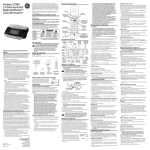Download Precor 9.41si Service manual
Transcript
C942 Treadmill ection Five — Troubleshooting Procedures Procedure 5.1 — Troubleshooting the Keypad and Upper PCA....................... 5-3 Procedure 5.2 — Troubleshooting the Optional Heart Rate System................ 5-5 Procedure 5.3 — Troubleshooting the Lift System............................................ 5-7 Procedure — Troubleshooting the External A.C. Power Source...................... 5-9 C942 Treadmill Procedure 5.1 — Troubleshooting the Keypad and Upper PCA If the function keys on the electronic console are unresponsive, the problem may be either the upper PCA or keypad. This troubleshooting procedure gives you the information you need to determine which of these components is malfunctioning. Procedure 1. Set the circuit breaker in the “off” position. WARNING Before continuing with this procedure, review the Warning and Caution statements listed in Section One of the Residential Treadmill Service Manual. 2. Remove the screws that secure the upper display assembly to the upper handrail. Carefully, pull some excess interconnect cable out from the targa upright. Rotate the display housing, so that the rear of the upper PCA is facing upward, and set the display housing on the upper handrail. 3. Attach the wrist strap to your arm, then connect the ground lead of the wrist strap to the treadmill frame. 4. Set the voltmeter to a range that will conveniently read +6 Vdc. 5. Set the circuit breaker in the “on” position. 6. Use a DVM, set for DC volts, and read between pin 6 of J2 and the each of the pins in Table 5.1 (no keys pressed) and Table 5.2 (with the appropriate key pressed)... Table 5.1. Voltage Test Points (Function Keys Not Pressed) Place the positive lead of the voltmeter on... Pin 3 of J4 Pin 4 of J4 Pin 5 of J4 Pin 7 of J4 Pin 8 of J4 Pin 9 of J4 Pin 10 of J4 The voltmeter should read... 5 Vdc ± 500 mVdc 5 Vdc ± 500 mVdc 5 Vdc ± 500 mVdc 5 Vdc ± 500 mVdc 5 Vdc ± 500 mVdc 5 Vdc ± 500 mVdc 5 Vdc ± 500 mVdc C942 Treadmill Table 5.2. Voltage Test Points (Function Keys Pressed) Place the positive voltmeter lead on... At the electronic console, press... The voltmeter should read between... Pin Pin Pin Pin Pin Pin Pin ENTER INCLINE DOWN INCLINE UP STOP SPEED DOWN SPEED UP QUICK START/CHANGE 0 Vdc and 500 0 Vdc and 500 0 Vdc and 500 0 Vdc and 500 0 Vdc and 500 0 Vdc and 500 0 Vdc and 500 3 of J4 4 of J4 5 of J4 7 of J4 8 of J4 9 of J4 10 of J4 mVdc mVdc mVdc mVdc mVdc mVdc mVdc 7. If the voltage readings match those listed inTables 5.1 and 5.2 and one or more keys do not function, replace the upper PCA. 8. If the voltage readings in Table 5.1 are incorrect, disconnect the keypad cable from the key pad connector and repeat the voltage measurements in 5.1. If the voltage readings are now correct, replace the display housing (keypad). If the voltage readings are still incorrect, replace the upper PCA. 9. If the voltage readings in Table 5.1 are correct and one or more voltage readings in Table 5.2 are incorrect, replace the display housing (keypad). 10. Set the circuit breaker in the “off” position. 11. If necessary, carefully re-connect the keypad cable to the keypad connector. 12. Remove the ground lead of the wrist strap from the treadmill frame, then remove the wrist strap from your arm. 13. Position the display enclosure on the display plate. Install the screws that secure the display enclosure to the display plate. 14. Check the operation of the treadmill as described in Section Three of this appendix. C942 Treadmill Procedure 5.2 — Troubleshooting the Optional Heart Rate System Note: The 9.41S and 9.41Si treadmills are not equipped with heart rate as standard equipment. Heart rate will be present only if the optional heart rate system has been installed. If the HEART RATE indicator does not blink with your heart beat when you perform Procedure 2.1, the problem may be either the heart rate receiver assembly or the chest strap assembly. This troubleshooting procedure gives you the information you need to determine which of these components is malfunctioning. Procedure 1. If you are referring to this procedure because the HEART RATE indicator did not blink properly when you performed Procedure 2.1... THEN... Skip to Step 6. OTHERWISE... Continue with the next step. 2. Plug the power cord into the wall outlet, then turn on the treadmill with the ON/OFF switch. 3. If necessary use conductive spray (Precor part number 37364-101) to ensure good contact between the chest strap transmitter and the user, put on the heart rate chest strap transmitter.Enter the diagnostics program per Procedure 2.1 or 2.2. Proceed to the heart rate test portion of the diagnostics program. HArt will be displayed in the right display window when the heart rate routine is accessed. 4. If the HEART RATE indicator blinks with your heart beat and the heart rate information displayed is correct... THEN... The Heart Rate system is operating correctly. There is no need to continue with this procedure. 5. OTHERWISE... Continue with the next step. Re-adjust the fit of the chest strap. If the HEART RATE indicator still does not blink as described in Step 4. If the chest strap transmitter has a replaceable battery, replace the battery. If the HEART RATE indicator still does not blink as described in Step 4... C942 Treadmill THEN... Continue with the next step. 6. Hold the Heart Rate Test Transmitter (Precor part number 20045-101) near the display housing. If the HEART RATE indicator on the electronic console blinks with the LED on the Smart Rate Test Generator... THEN... The chest strap assembly is bad. Wear a new chest strap assembly when you use the Heart Rate System. 7. OTHERWISE... The Heart Rate system is operating correctly. There is no need to continue with this procedure. Press ENTER to return to the User ID. OTHERWISE... The heart rate receiver assembly is bad. Replace the heart rate receiver as described in Procedure 5.4 of the Residential Treadmill Service Manual. C942 Treadmill Procedure 5.3 — Troubleshooting the Lift System System Description The lift system is powered by a 120 Vac lift motor that uses two independent motors windings, one operates the motor in an upward direction and one operates the motor in a downward direction. The motor contains a 10 KΩ potentiometer, driven by the motor, that indicates lift position. AC power to operate the lift motor is provided by a pair of triac. One triac provides power to the “up” winding of the lift motor and the other triac provides power to the “down” winding of the lift motor. The triacs are controlled either manually or by software control from the upper PCA. 1. If the lift motor will not move skip to step 7. If the lift motor moves and an error occurs continue with step 2. 2. Access the diagnostics program per Procedure 3.2 and proceed to the lift calibration portion of the diagnostics program. If the lift calibration number is 0 or 255 skip to step 3. Operate the lift, if the lift calibration number does not increment as the lift moves, skip to step 3. If the calibration number increments as the lift moves, recalibrate the lift per Procedure 5.3. If recalibration does not correct the problem, continue with step 3. 3. Set the treadmill circuit breaker in the “off” position. Using an ohmmeter, measure between terminal 4 (white wire) and terminal 6 (orange wire) of the P2 connector on the lower PCA. The measurement should be approximately 10 KΩ. If the measurement is open (∞) or significantly high or low, replace the lift motor. 4. Using an ohmmeter, measure between terminals 4 and 5 of P2 and measure between 5 and 6 of P2 on the lower PCA. The two measurements should total approximately 10 K Ω. If the measurement is open (∞) or significantly high or low, replace the lift motor. 5. If you have performed all of the above tests and an error still occurs when the lift motor operates, there are three parts that could cause the problem. There are not any good tests to check these parts other than substituting a known good part. They are lower PCA, ribbon cable and upper PCA. Replace only one part at a time. If the new part does not correct the problem replace the original part. 6. If you have performed all of the above tests and the lift system is still not functioning, call Precor Technical Support. 7. Set the treadmill circuit breaker in the “off” position. Remove the F2 (2 amp slow blow) fuse from the lower PCA. Measure the fuse with an ohmmeter. The measurement should be 1Ω or less. If the fuse is good, re-insert the fuse and skip to step 9. If the fuse is open (∞)or significantly high, replace the fuse. Before operating the lift motor it is necessary to perform a continuity test on the lift motor. C942 Treadmill 8. Remove the P2 connector from the lower board. Using an ohmmeter, measure between terminals 1 and 3 of P2, between terminals 1 and 2 of P2 and between terminals 2 and 3 of P2. The measurements should be approximately 14.5 Ω, 14.5Ω and 29Ω, respectively. If any of the measurements are significantly low, replace the lift motor. 9. Re-insert the P2 connector in the lower PCA. Set the treadmill circuit breaker in the “on” position. Using an AC voltmeter, monitor the voltage between terminals 1 and 2 (red and white wires) of the P2 connector. Enter the manual program and press the INCLINE ▲ key. The measurement should be approximately 120 Vac (line voltage). If the voltage is present and the lift motor moves normally, skip to step 10. The voltage will only be present until such time as an error occurs. If line voltage is not present skip to step 11. If line voltage is measured but the motor does not move, replace the lift motor. 10. Monitor terminals 1 and 3 (white and black wires) of P2. Enter the manual program and press the INCLINE ▼ key. The measurement should be approximately 120 Vac (line voltage). If the voltage is present and the lift motor moves normally skip to step 12. The voltage will only be present until such time as an error occurs. If line voltage is measured but the motor does not move, replace the lift motor. 11. If line voltage is not present in both steps 9 and 10, there are three parts that could cause the problem. There are not any good tests to check these parts other than substituting a known good part. They are lower PCA, ribbon cable and upper PCA. Replace only one part at a time. If the new part does not correct the problem replace the original part. 12. If you have performed all of the above tests and the lift system is still not functioning, call Precor Technical Support. C942 Treadmill Procedure 5.6 — Troubleshooting the External A.C. Power Source It is extremely important that any Precor treadmill be connected to and operated on a dedicated 20 amp A.C. circuit. A 20 amp dedicated circuit is defined as: a circuit fed by a 20 amp circuit breaker that feeds a single load. A treadmill operating from a non-dedicated circuit or a circuit breaker of less than 20 amps capacity will not have the necessary power available to operate normally under higher load conditions. The lack of available power can cause any number of symptoms ranging from numerous intermittent (seemingly inexplicable) error conditions, poor speed control, or tripping the house circuit breaker. If any of the above symptoms exist the external A.C. circuit must be checked and confirmed to be a 20 amp dedicated circuit before troubleshooting the treadmill. In addition the A.C. voltage must be checked. Nominal A.C. operating voltage on 120 Vac circuits is 105 Vac to 120 Vac. Nominal A.C. operating voltage on 240 Vac circuits is 208 Vac to 240 Vac. For operator safety considerations and to minimize electrostatic discharge conditions the A.C. frame ground continuity must also be verified to be a low resistance connection to the A.C. distribution ground bar. Important If the A.C. circuit feeding a treadmill is found to be a non-dedicated circuit or a circuit equipped with a circuit breaker with a capacity of less than 20 amps, the A.C. circuit must be corrected to be a 20 amp dedicated circuit before any reliable troubleshooting can be performed on the treadmill. More importantly, a non-dedicated circuit may constitute a safety hazard to the treadmill operator. 120 Vac Systems 120 Vac distribution systems utilize a single pole circuit breaker (hot lead) and a neutral lead connected to a common neutral (ground) bar. The A.C. safety ground (green wire) is connected to a separate ground bar in the distribution system. The most common problems found are (1) the circuit is fed by a circuit breaker of less than 20 amp capacity, (2) the circuit breaker correctly feeds a single A.C. outlet but the neutral is common between several A.C. outlets and (3) both the hot and neutral leads feed several A.C. outlets. The appropriate correction action or actions (see below) must be followed if any of the above conditions exist. Corrective actions should only be undertaken by a licensed electrician. 1. The circuit breaker feeding the treadmill is not a 20 amp circuit breaker. If the circuit breaker is greater than 20 amps, the circuit breaker should be replaced with a 20 amp circuit breaker. If the circuit breaker is less than 20 amps the circuit breaker must be replaced with a 20 amp circuit breaker and the wiring from the A.C. distribution must be capable of safely handing 20 amps. If the A.C. wiring is under sized, it must be replaced with wire capable of safely handling 20 amps. Please, refer to local electrical codes when determining the appropriate wire size for a 20 amp circuit. C942 Treadmill 2. The circuit breaker correctly feeds a single A.C. outlet but the neutral is common between several A.C. outlets. The common neutral lead must be removed from treadmill’s A.C. outlet and a new neutral lead from the treadmill’s A.C. outlet to the A.C. neutral distribution bar must be added. 3. Both the hot and neutral leads feed several A.C. outlets. Both the common neutral and hot leads must be removed from treadmill’s A.C. outlet and a new neutral lead and hot lead from the treadmill’s A.C. outlet to the A.C. neutral distribution bar and circuit breaker must be added. 240 Vac Systems 240 Vac distribution systems utilize a double pole circuit breaker (two hot leads) The A.C. safety ground (green wire) is connected to a ground bar in the distribution system. The most common problems found are (1) the circuit is fed by a circuit breaker of less than 20 amp capacity and (2) both the hot leads feed several A.C. outlets. The appropriate correction action or actions (see below) must be followed if any of the above conditions exist. Corrective actions should only be undertaken by a licensed electrician. 1. The circuit breaker feeding the treadmill is not a 20 amp circuit breaker. If the circuit breaker is greater than 20 amps, the circuit breaker should be replaced with a 20 amp circuit breaker. If the circuit breaker is less than 20 amps the circuit breaker must be replaced with a 20 amp circuit breaker and the wiring from the A.C. distribution must be capable of safely handing 20 amps. If the A.C. wiring is under sized, it must be replaced with wire capable of safely handling 20 amps. Please, refer to local electrical codes when determining the appropriate wire size for a 20 amp circuit. 2. Both the hot leads feed several A.C. outlets. Both hot leads must be removed from treadmill’s A.C. outlet and two new hot leads from the treadmill’s A.C. outlet to the circuit breaker must be added. A licensed electrician may use the followings hints to determine if an A.C. service is dedicated. 1. If, on a 120 Vac system, the A.C. distribution panel contains more circuit breakers than neutral leads, the system has shared neutral leads and is not dedicated. 2. If an A.C. outlet (120 or 240 Vac) has multiple hot and/or neutral leads, it is not a dedicated. 3. If either of the above conditions exist, the system is not dedicated. However, absence of the above conditions does not necessarily mean that the system is dedicated. If any doubt exists about A.C. systems dedication, point to point tracing of the A.C. wiring may be the only way to prove system dedication.


















